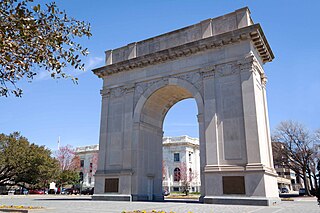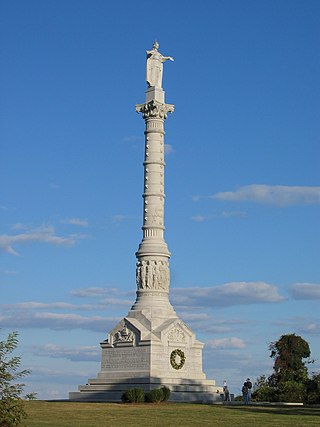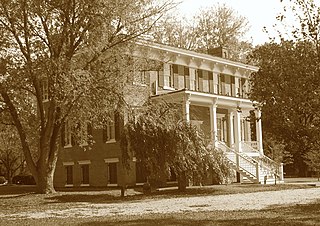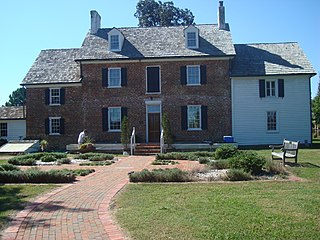Related Research Articles

Williamsburg is an independent city in the Commonwealth of Virginia, United States. As of the 2020 census, it had a population of 15,425. Located on the Virginia Peninsula, Williamsburg is in the northern part of the Hampton Roads metropolitan area. It is bordered by James City County on the west and south and York County on the east.

Newport News is an independent city in the Commonwealth of Virginia in the United States. At the 2020 census, the population was 186,247. Located in the Hampton Roads region, it is the fifth-most populous city in Virginia and 140th-most populous city in the United States.

Colonial National Historical Park is a large national historical park located in the Hampton Roads region of Virginia operated by the National Park Service. It protects and interprets several sites relating to the Colony of Virginia and the history of the United States more broadly. These range from the site of the first English settlement at Jamestown, to the battlefields of Yorktown where the British Army was defeated in the American Revolutionary War. Over 3 million people visit the park each year.

Lee Hall or Lee Hall Mansion is a historic brick plantation house that was built during the period from 1848 to 1859. The community of Lee Hall, Virginia is named for it. The house and village are located near the junction of U.S. 60 and VA 238, in Newport News, Virginia.

Endview Plantation is an 18th-century plantation which is located on Virginia State Route 238 in the Lee Hall community in the northwestern area of the independent city of Newport News, Virginia.
Richneck Plantation was located on the Virginia Peninsula on the northern shore of the James River between Hampton Roads and Jamestown in the English colony of Virginia. The Richneck manor house's foundation was discovered during construction of the George J. McIntosh elementary school, and became an archeological dig, then listed on the National Register of Historic Places.

Cedar Creek and Belle Grove National Historical Park became the 388th unit of the United States National Park Service when it was authorized on December 19, 2002. The National Historical Park was created to protect several historically significant locations in the Shenandoah Valley of Northern Virginia, notably the site of the American Civil War Battle of Cedar Creek and the Belle Grove Plantation.

Highland, formerly Ash Lawn–Highland, located near Charlottesville, Virginia, United States, and adjacent to Thomas Jefferson's Monticello, was the estate of James Monroe, a Founding Father and fifth president of the United States. Purchased in 1793, Monroe and his family permanently settled on the property in 1799 and lived at Highland for twenty-five years. Personal debt forced Monroe to sell the plantation in 1825. Before and after selling Highland, Monroe spent much of his time living at the plantation house at his large Oak Hill estate near Leesburg, Virginia.

Lower Brandon Plantation is located on the south shore of the James River in present-day Prince George County, Virginia.

Chinqua Penn Plantation is an English manor home in Reidsville, North Carolina in Rockingham County, North Carolina, United States,. It is a private residence and was closed to the public in 2012. The home was built by Thomas Jefferson Penn and Margaret Beatrice Shoellkopf Penn in the 1920s. The name "Chinqua Penn" was derived from the chinquapin, a species of American chestnut that was once plentiful in the area.
Captain Samuel Mathews was a Virginia planter, political figure, and the father of Governor Samuel Mathews.

The Reynolds Homestead, also known as Rock Spring Plantation, is a slave plantation turned historical site on Homestead Lane in Critz, Virginia. First developed in 1814 by slaveowner Abram Reynolds, it was the primary home of R. J. Reynolds (1850-1918), founder of the R. J. Reynolds Tobacco Company, and the first major marketer of the cigarette. Upon liberation of the plantation in 1863, 88 people were freed from captivity and enslavement. It was later designated a National Historic Landmark in 1977. The homestead is currently an outreach facility of Virginia Tech, serving as a regional cultural center. The house is open for tours.
Belvoir was the plantation and estate of colonial Virginia's prominent William Fairfax family. Operated with the forced labor of enslaved people, it sat on the west bank of the Potomac River in Fairfax County, Virginia, at the present site of Fort Belvoir. The main house — called Belvoir Manor or Belvoir Mansion — burned in 1783 and was destroyed during the War of 1812. The site has been listed on the National Register of Historic Places since 1973 as "Belvoir Mansion Ruins and the Fairfax Grave."
This is a list of the National Register of Historic Places listings in Newport News, Virginia.

Ferry Plantation House, or Old Donation Farm, Ferry Farm, Walke Manor House, is a brick house in the neighborhood of Old Donation Farm in Virginia Beach, Virginia. The site dates back to 1642 when Savill Gaskin started the second ferry service in Hampton Roads to carry passengers on the Lynnhaven River to the nearby county courthouse and to visit plantations along the waterway. A cannon was used to signal the ferry, which had 11 total stops along the river. The first ferry service was started nearby by Adam Thoroughgood.

Boldrup Plantation Archeological Site is a historic archaeological site located at Newport News, Virginia. A modern residential development has succeeded the 17th-century plantation. Three successive colonial governors lived at Boldrup : John Harvey, Samuel Stephens (1629-1669) and William Berkeley (1605-1677). The last owned it through his wife, Frances Culpeper Berkeley, who with her new husband sold it to another member of the Virginia Governor's Council William Cole. Although it remained in the Cole family for another two generations, his namesake grandson William Cole III, advertised it for sale in 1776 and again in 1782, by which time he was living at Buckland plantation in Charles City County, which he had also inherited. Soon thereafter, Boldrup was owned by Judge Richard Cary, who was married to Mary Cole, daughter of William Cole Jr. and lived at Peartree Hall nearby, and at his death bequeathed it to his son Miles Cary. The Cary family owned several nearby plantations in Warwick and adjoining counties, including Richneck, Marshfield and Windmill Point, but never resided at Boldrup.

Denbigh Plantation Site, also known as Mathews Manor, is a historic archaeological site located at Newport News, Virginia.

First Denbigh Parish Church Archeological Site is a historic archaeological site located at Newport News, Virginia. The site is located on the bluff overlooking the Warwick River at the mouth of Church Creek. It took its name from nearby Denbigh Plantation and was constructed in 1636. A new structure was built at a nearby site by 1686 and replaced the former building. A frame structure for Warwick Parish was built on the site about 1774 and the Baptists began using it by 1834.

The First Baptist Church is a historic church building, now housing the non-denominational Dominion Outreach Worship Center, at 119 29th Street in Newport News, Virginia. Built in 1902, the church is a prominent local example of Romanesque Revival architecture executed in stone. It was designed by R.H. Hunt of Chattanooga. It is fronted by a three-arch recessed porch, flanked by a tower on the left whose upper stages have rounded corners, and is capped by a pyramidal roof with conical turrets at the corners. The congregation was organized in the 1880s, and occupied this site until the 1980s. The congregation opened a suburban chapel in 1979. It operated on both sites for many years before closing the 29th Street church.
References
- ↑ "National Register Information System". National Register of Historic Places . National Park Service. July 9, 2010.
- ↑ "NRHP nomination for Endview" (PDF). Virginia DHR. Retrieved October 29, 2017.
- ↑ "Framework for the Future". City of Newport News. Retrieved October 29, 2017.